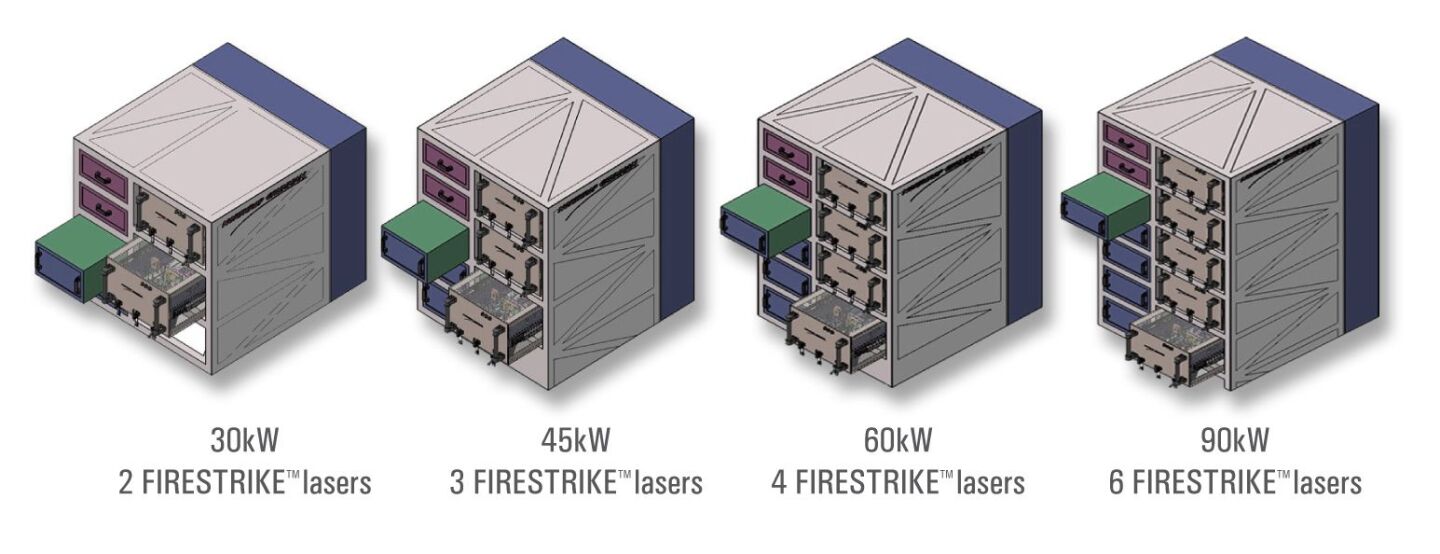Practical laser weapons came another step closer to reality recently as defense contractor Northrop Grumman tested the latest version of its Firestrike solid-state lasers. On May 1st, the company announced that it had completed trials at its Redondo Beach laboratory of a more powerful and rugged generation of its slab lasers, that combine with improved sensor capacities to create a general laser component that can provide the military with a wide range of greatly enhanced defensive and offensive laser capabilities.
The dream of a laser “death ray” has been around since the invention of the laser in the 1960s. This isn’t surprising, since lasers are coherent light beams with enough focus to bounce a beam off the Moon, and a laser can concentrate enough energy on a target to burn through steel. The latter was a common laboratory trick in those early days, where engineers would show off the power of the laser by cutting through razor blades so often that an early unit for measuring laser power was in “Gillettes."
Cutting through a razor blade on a bench top and piercing armor plate or bringing down a missile in flight are very different things, however. The potential of laser weapons was offset by problems with power, waste heat, aiming, atmospheric interference, and the bulk and fragility of the apparatus, to name just a few. Though laser weapons became a staple of science fiction, in the real world lasers were relegated to industry and medicine with the only military applications being in range finding and communications.
However, this didn’t mean that the military lost all interest in laser weapons. In the1980s, the United States poured billions of dollars into anti-ballistic missile lasers, the British deployed a system for dazzling enemy pilots and the Soviets experimented with a tank armed with a laser weapon. By the 1990s, the Americans had installed an anti-missile laser inside a Boeing 747 for field tests and in the 21st century, Coalition forces in Iraq and Afghanistan were using lasers to detonate IEDs ... and yet, practical weapons remained elusive. Despite setbacks, the American airborne laser, for example, had considerable success, but the system was based on a laser that used highly toxic chemicals to generate the beam. The equipment was expensive, extremely fragile, dangerous to be around, and a logistical nightmare.
The Firestrike laser was developed with a different philosophy than previous efforts. Instead of building an extremely powerful laser and then figuring out how to make it practical, Northrop Grumman took the approach of making small, rugged lasers and then working on how to scale them up to practical size. The Firestrike system tries this by using a “slab” laser, in which the lasing element of the device is a slab of glass or crystal about the size of a microscope slide that’s been doped with a rare earth element such as neodymium or chromium. This is pumped with a light source, such as a flash lamp, and the photons inside the slab are induced to “cascade," that is, move in the same direction, and generate a laser.
Gamma
The latest Firestrike laser, named Gamma, generates a stable, high-quality beam for 1.5 hours. Its power output is only 13.3 kilowatts, which isn’t nearly large enough to do much on its own, but the recent tests did prove the power and ruggedness of the system. The Gamma is smaller than previous Firestrikes, weighing in at only 500 pounds (227 kg) and measuring about the same size as a pair of countertop microwaves. The Gamma’s small size and low power may give the impression that it doesn’t come to much on the battlefield, but Northrop Grumman’s design makes the Gamma “chainable." That is, individual Gamma units can be linked together to combine their individually weak lasers into one extremely powerful, high-quality beam. By linking together the slab laser elements from several Gamma units, a laser of 100 kilowatts, the lower threshold for a battlefield laser, that weighs in at 1.5 (1.4 tonnes) tons and requires one megawatt of power to operate, is possible.

One and a half tons seems pretty heavy for a weapon, but mounted in an armored vehicle, a warship or at a land base, it’s fairly light. The Gamma is also an improvement on previous iterations of the Firestrike system in that the laser is much simpler and more rugged with fewer components and new mounts that greatly reduce vibration.
The tests carried out at the Redondo Beach laboratory consisted of firing the Gamma laser at the skin of a surplus BQM-7 drone and other components at short range, under conditions that simulated a full-scale combat laser operating at a range of several miles. "The Gamma laser was tested at a beam quality of 1.4, which beat the design goal of 1.5, and we expect it to keep improving," said Dan Wildt, vice president, directed energy systems, Northrop Grumman Aerospace Systems. "A perfect beam quality is 1. Owing to its excellent beam quality, the 13.3 kilowatt Gamma is also brighter than its design goal, meaning it can put more power on target at range.”
As far as applications of the Gamma laser and the Firestrike line in general, Wildt said, "The Firestrike laser, announced in 2008, forms the backbone near-term laser weapon systems from Northrop Grumman. Combined with advanced electro optical and/or infrared sensors, Firestrike line replaceable units and their subsystems can provide military services with active defense, offensive precision strike and enhanced situational awareness capabilities, all in the same weapon system."
Given the Pentagon’s continuing interest in lasers and the increasing need to develop defenses against new, faster missiles of all grades, it appears as if the age of the laser weapon is fast approaching.
One of the Firestrike tests can be seen in the video below.
Source: Northrop Grumman









